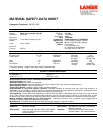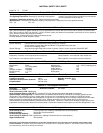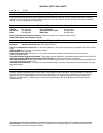
MATERIAL SAFETY DATA SHEET
Page
2 of 3 CP-430
Section 5: Fire Fighting Measures
Suitable extinguishing media: CO
2
, dry chemical, foam or water.
Fire Fighting Instructions: Generally by sprinkling or extinguisher.
Unusual Fire or explosion hazards: Combustible
powder. Dust of this product at sufficient concentrations
can form explosive mixtures with air.
Hazardous Combustion Products: CO2, Carbon Monoxide and smoke.
Miscellaneous: This material is capable of creating a dust explosion. Keep away from heat, sparks and flame.
UEL: n/a LEL: n/a
Section 6: Accidental Release Measures
Spill / leak Procedures: If spilled, sweep up using an approved toner vacuum with a 0.5 micron filter or smaller, such as the Atrix
AAA Toner Vacuum or 3M Toner Vacuum. Use of a vacuum cleaner not rated for toner particles, could result in a fire or personal
injury. Remove residue with soap and cold water.
Miscellaneous: Keep product out of sewers and watercourses.
Personal protection: Avoid inhalation of dust.
Section 7: Handling and Storage
Special Handling:
Cleanse skin after contact before eating, drinking or smoking.
Do not handle in areas where the wind blows. Flying powder may enter eyes.
Minimize the breathing of dust.
Special Storage: Avoid direct sunlight. Keep out of reach of children. Store in a cool, dry place. Below 35C (95F)
Section 8: Exposure Control and Personal Protection Information:
Respiratory Protection: none required under normal use. Hand Protection: none required under normal use.
Eye Protection: none required under normal use. Skin Protection: none required under normal use.
Section 9: Physical and Chemical Properties
CHARACTERISTICS:
Appearance: Black Melting point: 110 – 150°C (softening point)
Form: Fine solid powder Vapor pressure: N/a
Odor: Odorless Vapor density: N/a
Solubility in Water: Negligible Evaporation rate: N/a
Specific gravity: 1.1 – 1.5 Boiling point: N/a
Density: N/a
Section 10: Stability and Reactivity
Conditions to avoid: None Materials to avoid: None
Hazardous decomposition products: Will not occur Stability: Stable
Polymerization: Will not occur
Section 11: Toxicological Information:
Ames test: Negative Acute skin irritation: non-irritant
Eye Effects: non-irritant
Acute oral toxicity: LD50 >5000mg/kg
Acute inhalation effects: LC50 (4H) is in excess of 5.37 mg/l (this was the highest attainable concentration.
Special effects: Carcinogenicity: In 1996 the IARC reclassified Carbon Black as a Group 2B carcinogen (possible human
carcinogen). This evaluation is given to carbon black for which there is inadequate human evidence, but sufficient animal
evidence. The latter is based upon the development of lung tumors in rats receiving chronic inhalation exposures to free carbon
black at levels that induce particle overload of the lung. Studies performed in animal models other than rats have not
demonstrated an association between carbon black and lung tumors. Moreover, 2-years cancer bioassay using a typical toner
preparation containing carbon black did not demonstrate an association between toner exposure and tumor development in rats.
Section 12: Environmental / Ecological Information
Acute toxicity to fish: LC50 is greater than 1000mg/l (Estimated from the same product)
Bioaccumulation: Not known in bioaccumulation
Persistence/Degradability: Not known
Acute toxicity to daphnia: EC50 is greater than 1000mg/l (Estimated from the same product)
Algae inhibition test: Not available
In
formation on this data sheet represents our current data and best opinion as to the proper use in handling of this product under
rmal conditions.
On the basis of the data available to us, this product is not a dangerous substance. One should, however, observe the
ual precautionary measures for dealing with chemicals.
no
us





